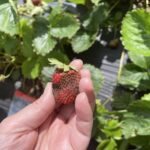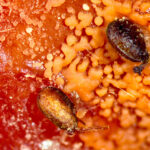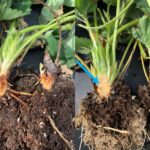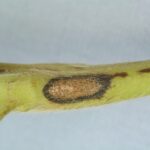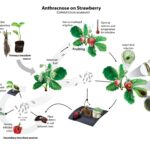Wet weather throughout the Midwest has resulted in explosive anthracnose outbreaks in Indiana, Illinois, Kentucky and Ohio. Although it is too late to save the fruit crop, actions can be taken to protect daughter-plant establishment and to develop a plan for future disease management.
Anthracnose is one of the most devastating diseases impacting strawberry production in the Midwest and is caused by several species of fungi in the genus Colletotrichum. These fungi infect strawberry:
- flowers and peduncles, preventing fruit development.
- fruit, preventing harvest.
- crowns, causing plant death.
- runners, preventing new plants from becoming established in perennial production systems, and
- and even leaves and petioles.
Symptoms
The symptoms and sign of anthracnose can be as obvious as fruit rot with firm, sunken lesions (Fig. 1). Lesions are varying shades of brown, but under warm, wet conditions, lesions may ooze salmon-colored spores (Fig. 2). Crown rot symptoms vary from the dramatic wilting of the entire plant to simple stunting and ‘unthriftiness’. Splitting the crown of infected plants reveals a rusty, orange-red- brown discoloration (Fig. 3). Unlike red stele, caused by Phytophthora, the roots of the anthracnose infected plant remain healthy.
Less obvious symptoms of anthracnose infection include blossom infections (Fig. 4), which often precede fruit infection. Infections of petioles, peduncles, stolons, and leaves are often inconspicuous and easily overlooked (Fig. 5). Lesions on these plant parts may girdle peduncles, causing flower or fruit death while infections on stolons cause the death of unrooted daughter plants.
Life Cycle
The fungi that cause anthracnose are commonly introduced into the field on infected, asymptomatic transplants. Under warm, wet conditions, the latent fungal infection begins to invade the infected plant, producing abundant spores (conidia). These spores are spread via wind-driven rain and splash to neighboring plants. Spore production occurs during any period of warm, wet weather. Injured or damage plant material is highly susceptible to infection (Fig. 6).
Colletotrichum fungi overwinter in infected plants, plant debris, and especially mummified fruit. These fungi can persist in soils for approximately nine months in the absence of a host. Some weeds and even nearby fruit and vegetables may serve as hosts for some species of Colletotrichum, providing another means of persistence. During warm, rainy, or humid weather, the pathogens become active, producing abundant spores that are readily spread to new hosts. Spores continue to be produced throughout spring and summer, whenever conditions are favorable.
- Figure 1. Anthracnose fruit rot (AFR). Photo by Wenjing Guan, SWPAC, Purdue University.
- Figure 2. Spores oozing from anthracnose lesion. A single fruit is capable of producing hundreds of thousands of spores.
- Figure 3. Anthracnose crown rot (ACR). Note orange-red stele of the infected plants on the left, compared to the healthy plants on the right. Photo by Raj Singh, LSU.
- Figure 4. Damaged blossoms and buds are readily colonized by the anthracnose and botrytis fungi. Photo by Janna Beckerman.
- Figure 5. Anthracnose infection of petiole, peduncle and runners are less conspicuous but result in a loss of both fruit and daughter plants. Photo by Steve Koike.
- Figure 6. The disease cycle of strawberry anthracnose. Illustrated by Madeline Dowling, Clemson University.
Management
Starting with disease-free plants and/or plugs are essential for successful strawberry production since this disease is introduced to the field by infected plant material. Unfortunately, no greenhouse or nursery can certify that 100% of their plants are free from these pathogens. For this reason, it is important to carefully inspect all plants and plugs, discarding any suspicious looking material. In this instance, not discarding questionable plants can cost far more than what might be saved by not discarding infected plants.
Fungicide dips can be used on transplants before planting in production fields, however, recent research on the role of dips in disease management have shown inconsistent results. The information is available in the Midwest Fruit Pest Management Guide but is not necessarily recommended because of a lack of clear results. Finally, these treatments will not rescue infected plants but will only prevent new infections from occurring while the plant is getting established.
Although not common in Midwest strawberry production, use drip irrigation when needed and avoid overhead irrigation to reduce splashing. Straw mulching further reduces water splash and disease spread in perennial matted row production.
Sanitation is a cornerstone of integrated disease management. Do not work plants when wet, which can injure plants and promote disease spread. Cull infected plants and remove all infected plant material. A single infected berry can produce hundreds of thousands of spores (Fig. 2). To limit pathogen spread, work from clean to infected areas, always picking the infested area last. Never move people or machinery from high disease areas to lower disease areas.
Since weeds serve as alternate hosts, manage weeds in and around the field to improve air flow and drying of strawberries in the field, while reducing another potential source of inoculum and disease spread. Every few years, rotate out of strawberries for at least two (and preferably three) years. In the absence of a susceptible host, including weeds, the inoculum level (spore load) in the field will steadily decline.
Fungicides are available to protect plants when environmental conditions are ideal for infection. To protect against anthracnose fruit rot, begin applications pre-bloom and continue through harvest. Choosing the right fungicide at the right time can be a challenge. This Strawberry Disease Management Guide has an extensive list of options at every stage of strawberry production. This guide will be updated and included in the 2023 Midwest Fruit Pest Management Guide. Remember that fungicides must be applied before infection occurs—not after symptoms are visible.
Although some varieties of strawberry are less susceptible than others, clear answers for Midwest strawberry growers are lacking. Current work to evaluate different strawberry cultivars is being performed by Dr. Wenjing Guan at the Southwest Purdue Agricultural Center.
